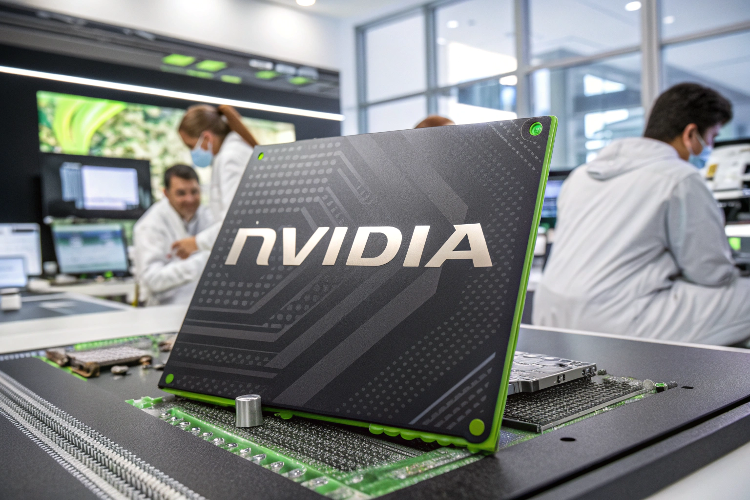Blog
How NVIDIA Became a Leader in AI & Gaming Chips ?
Case Studies & Success Stories ▪ 2025-03-13

NVIDIA is one of the most influential technology companies in the world, pioneering graphics processing units (GPUs), artificial intelligence (AI), and high-performance computing. Originally known for gaming GPUs, NVIDIA has expanded its reach into AI, machine learning, cloud computing, autonomous vehicles, and data centers.
With its cutting-edge hardware and software innovations, NVIDIA has positioned itself as the undisputed leader in AI and gaming chips, powering everything from AAA gaming experiences to AI-driven research and enterprise computing.
This blog explores how NVIDIA rose to dominance, its key innovations, and how it continues to shape the future of AI and gaming.
1️⃣ The Origins of NVIDIA: Revolutionizing Graphics Processing
🚀 NVIDIA was founded in 1993 by Jensen Huang, Chris Malachowsky, and Curtis Priem with a vision to revolutionize computer graphics.
At the time, CPUs struggled to handle complex graphical tasks, making gaming and 3D rendering inefficient. NVIDIA saw an opportunity to develop a dedicated graphics processor to offload these tasks, leading to the birth of the modern GPU (Graphics Processing Unit).
✅ Early NVIDIA Milestones:
✔ 1999 – GeForce 256: The world’s first GPU, capable of real-time 3D rendering.
✔ 2006 – CUDA Platform: Allowed developers to use GPUs for tasks beyond graphics, unlocking AI and deep learning potential.
✔ 2016 – AI-Optimized GPUs: NVIDIA’s Pascal architecture GPUs revolutionized AI computing.
💡 Example: The launch of CUDA transformed GPUs from gaming hardware into AI supercomputers.
🔗 Pro Tip: Identifying new applications for existing technology can lead to market expansion.
2️⃣ How NVIDIA Dominated the Gaming Industry
✔ NVIDIA became the undisputed leader in gaming GPUs, creating high-performance graphics cards for gamers and professionals.
✔ Its GeForce series set industry standards for graphics quality, frame rates, and ray tracing.
✔ NVIDIA’s exclusive technologies like DLSS and RTX Ray Tracing made gaming more realistic than ever.
✅ Key Innovations in NVIDIA’s Gaming Dominance:
✔ Real-Time Ray Tracing (RTX Technology) – Enhanced lighting, shadows, and reflections.
✔ DLSS (Deep Learning Super Sampling) – AI-powered upscaling for higher performance.
✔ G-SYNC Technology – Eliminates screen tearing for smoother gaming.
✔ Cloud Gaming (GeForce NOW) – Streaming high-end games without expensive hardware.
💡 Example: Cyberpunk 2077 with RTX On demonstrated the next level of realism in gaming.
🔗 Pro Tip: Constantly improving technology gives companies a competitive edge in gaming.
3️⃣ The AI Revolution: How NVIDIA Became the King of AI Hardware
✔ NVIDIA’s biggest transformation came when it expanded beyond gaming into AI and deep learning.
✔ The CUDA platform enabled researchers to use GPUs for AI model training, unlocking massive computational power.
✔ NVIDIA’s AI-powered GPUs now dominate data centers, cloud computing, and machine learning applications.
✅ NVIDIA’s AI & Deep Learning Contributions:
✔ AI Supercomputers – NVIDIA GPUs power AI training models for Tesla, OpenAI, and Google.
✔ NVIDIA Tensor Cores – Designed specifically for deep learning acceleration.
✔ AI-Driven Healthcare & Drug Discovery – Used for medical imaging and research.
✔ Self-Driving Cars – NVIDIA’s AI chips power autonomous vehicle systems.
💡 Example: OpenAI used NVIDIA GPUs to train ChatGPT, proving the importance of GPUs in AI development.
🔗 Pro Tip: Investing in AI-driven hardware expands market opportunities beyond gaming.
4️⃣ Data Centers & Enterprise Computing: The New Growth Engine
✔ NVIDIA shifted focus from consumer gaming to enterprise AI and cloud computing.
✔ Its GPUs power data centers, cloud AI models, and scientific computing.
✔ Companies like Microsoft, Amazon, and Google rely on NVIDIA for cloud-based AI workloads.
✅ NVIDIA’s Role in Data Centers:
✔ AI-Powered Data Processing – NVIDIA chips accelerate big data analytics.
✔ Cloud GPU Computing – Available on AWS, Azure, and Google Cloud.
✔ HPC (High-Performance Computing) – Used in scientific research and financial modeling.
💡 Example: NVIDIA’s A100 and H100 GPUs are the gold standard for AI research and data center computing.
🔗 Pro Tip: Expanding into enterprise markets ensures sustainable revenue growth.
5️⃣ NVIDIA’s Role in Autonomous Vehicles & Robotics
✔ NVIDIA’s AI-powered chips are essential for self-driving cars and robotics.
✔ Its NVIDIA DRIVE platform provides real-time AI decision-making for autonomous vehicles.
✔ Automakers like Tesla, Mercedes, and Volvo integrate NVIDIA chips in their AI-driven cars.
✅ How NVIDIA is Driving Autonomous Technology:
✔ Self-Driving AI Models – Processes real-time road data for autonomous driving.
✔ Robotics & Industrial AI – Powers warehouse robots and smart manufacturing.
✔ Edge AI Computing – AI-powered devices that function without cloud dependence.
💡 Example: Tesla’s Autopilot uses NVIDIA AI chips to process driving decisions.
🔗 Pro Tip: AI-powered hardware has applications far beyond traditional computing.
6️⃣ NVIDIA’s Competition: How It Stays Ahead
✔ While AMD and Intel compete in GPUs, NVIDIA dominates in AI computing and deep learning.
✔ NVIDIA focuses on software-hardware integration, giving it an advantage over rivals.
✔ NVIDIA continuously invests in R&D, acquisitions, and AI startups to stay ahead.
✅ How NVIDIA Maintains Leadership:
✔ Exclusive AI Software (CUDA, TensorRT) – No direct competitor.
✔ Acquisitions (ARM, Mellanox) – Strengthening AI and networking capabilities.
✔ Partnerships with Tech Giants – AI collaborations with Microsoft, Google, and Tesla.
💡 Example: NVIDIA’s AI cloud services make it an essential partner for global tech firms.
🔗 Pro Tip: Combining hardware and proprietary software ensures long-term market leadership.
7️⃣ The Future of NVIDIA: What’s Next?
🚀 What’s Next for NVIDIA?
✅ AI-Driven Cloud Computing – Expanding AI supercomputing for enterprise clients.
✅ Quantum Computing Integration – Researching next-gen computing architectures.
✅ Metaverse & AI-Generated Worlds – Powering the future of virtual reality.
✅ Energy-Efficient AI Chips – Developing AI chips with lower power consumption.
✅ Edge AI & Smart Devices – AI-powered smart cameras, IoT devices, and automation.
💡 Example: NVIDIA is investing in AI-generated gaming worlds and metaverse technologies.

